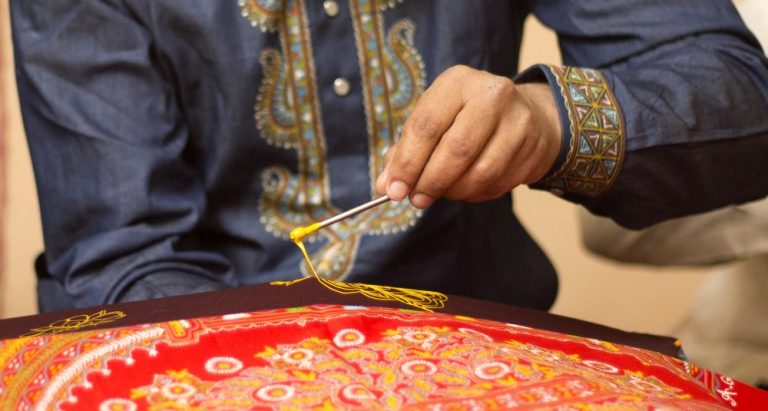Rogan – The Wearable Painting Art
Rogan is a conventional hand painting Art of Kutchh, Gujarat. It is an
ancient skill originated in Persia and came down to Kutchh around 300 years
ago. Rogan means oil-based in Persian as flower motifs and designs speak of
Persian influence. This art was practiced in Baroda, Patan, Khavada of Kutch in
Gujarat and Nasik of Maharashtra but now it is only done by Khatri communities
of Nirona village in Kutchh. Rogan is a form of painting used to decorate the
fabrics. Rogan painting is known for its technique and beauty which gives the
impression of embroidery. Unlike other folk paintings of India, Rogan painting
has not explored until now.
Khatri the community of Kutchh is said to be a perfectionist in this art. This community
has been engaged in this art for centuries and this technique has been passed
from several generations. Only nine members of the Khatri communities are
practicing this art. The eighth generation of the Khatri family has been
practicing the ancient art. It is the bread earner for a Khatri family.
Gafurbhai Khatri, head of the Khatri family has won National award (1997) and
Padmashri (2019) for Rogan art. He has ensured to keep this art alive and make
his family learns and practices Rogan art. The other craftsman gave up this
craft as they were not getting a good return and switched to another
profession.
 |
| Artisan Making Rogan painting |
Making Rogan art
follows three basic steps like making Rogan gel, mixing color and making Rogan
painting on fabric. Raw materials used for the painting are thick bright paste
and color paste. The thick paste is prepared by boiling Castrol oil. Castrol
seeds are collected and crushed from which the oil is extracted. This oil is
heated over more than five to six hours to make it thick. Oil heating and use
it when it is cold is time-consuming and takes lots of effort. Artisans used
to make natural colors from flowers, plants, soil, rocks, etc. but now they are
using readymade pigment colors, which make the Rogan making process simple and
easier. These colors are then added with Rogan gel to form a Rogan color
paste. Now from this mixture, Artisans start making a design on fabric.
Before it was only painted on cotton fabric while now it is painted on
cotton, silk and polyester. Designs are drawn on the half area of the fabric.
Artisans take a lump of color paste on the palm and mixed with a stylus
(equipment for painting process) by another hand. With this mixing color paste,
artists create different types of designs on fabric in a thread-like structure.
One of the amazing things about this art is these patterns are drawn on the
cloth without using any reference or drawings. Making
drawing requires not only skill but patience, concentration, a sense of
proportion and aesthetic appreciation. The most commonly used colors are
yellow, blue, orange, and red. Artisans use primarily geometric and floral
design in Rogan Paintings.
 |
| Designs of Rogan Art |
Rogan art was used to decorate the Bedsheets, Pillow covers, Bridal garments like Ghaghara, Dupatta and other Dowry products, etc. However, people now have shown interest in wall pieces which gained more popularity in today's time. Rogan painted cloth is also used for making pillow covers, tablecloths, wall hangings, file folders, decorative pieces and even saris. People can even get their own clothing customized directly from the artisans by contacting them. Rogan art is available from 100 INR to more than 20,000 INR depending upon the size, design and time consumed by artisans. Rogan art is also travelled from Kutchh to White house. Prime Minister Mr. Narendra Modi gifted a rare form of Rogan painting “Tree of life” to the US president, Mr. Obama during his visit to the US in 2014.
But today,
it has only become the showcase during the Kutchh Run Utsav festival where
all tourists visit this village and see this art. Due to a lack of awareness
among Indian and International consumers, the new generation has no
interest in continuing this craft. With printing technology, our ancient art is
finding difficulty to maintain their identity. Still, nine people from the same
family are trying hard to save this art from becoming unknown to the world.



Comments
Post a Comment